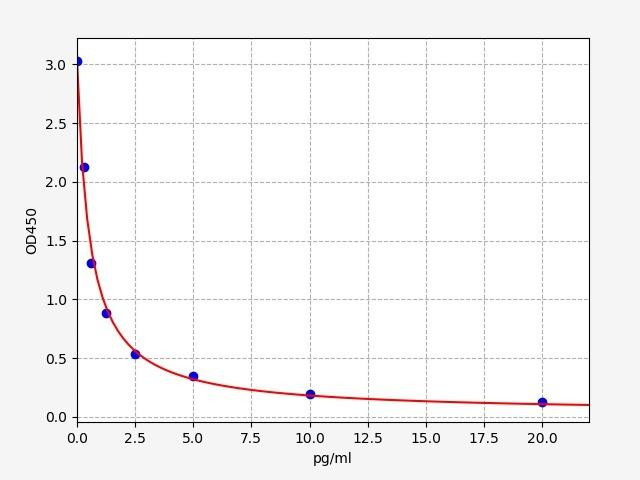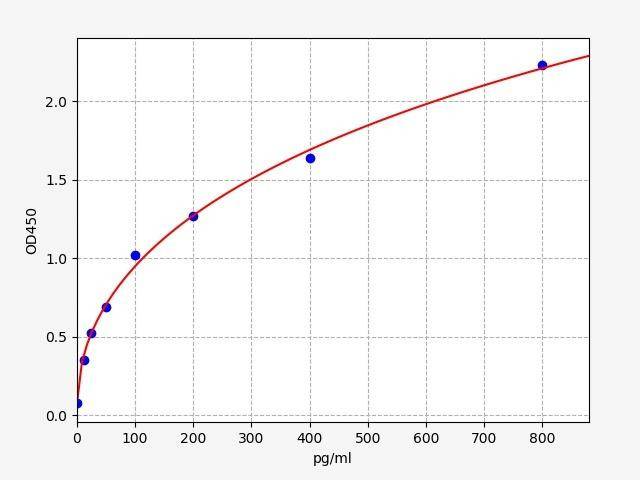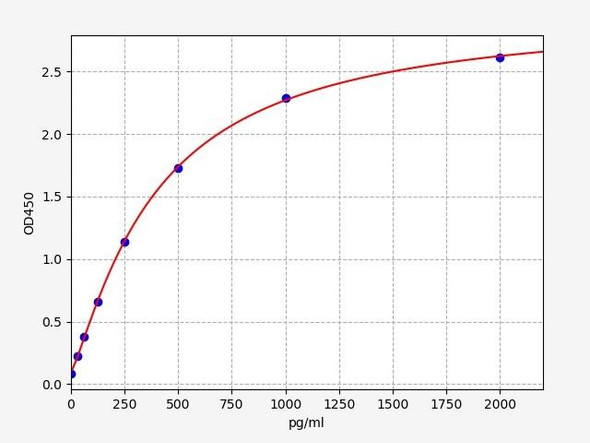Intro paragraph
Description
Rat Copeptin ELISA Kit
Key Features
| Save Time | Pre-coated 96 well plate | |
| Quick Start | Kit includes all necessary reagents | |
| Publication Ready | Reproducible and reliable results |
Overview
| Product Name: | Rat Copeptin ELISA Kit |
| Product Code: | RTFI01350 |
| Size: | 96 Assays |
| Alias: | CPP, Copeptin |
| Detection Method: | Sandwich ELISA, Double Antibody |
| Reactivity: | Rat |
| Sensitivity: | 1.875pg/ml |
| Range: | 3.125-200pg/ml |
| Storage: | 4°C for 6 months |
| Note: | For Research Use Only |
Additional Information
| Recovery | Matrices listed below were spiked with certain level of Rat Copeptin and the recovery rates were calculated by comparing the measured value to the expected amount of Rat Copeptin in samples. Please contact us for more information. |
| Linearity: | The linearity of the kit was assayed by testing samples spiked with appropriate concentration of Rat Copeptin and their serial dilutions. The results were demonstrated by the percentage of calculated concentration to the expected. Please get in contact for more information. |
| CV(%) | Intra Assay <8 Inter Assay <10 |
Kit Components
| Component | Quantity | Storage |
| ELISA Microplate (Dismountable) | 8x12 strips | 4°C for 6 months |
| Lyophilized Standard | 2 | 4°C/ -20°C |
| Sample/Standard Dlution Buffer | 20ml | 4°C |
| Biotin-labeled Antibody (Concentrated) | 120ul | 4°C (Protection from light) |
| Antibody Dilution Buffer | 10ml | 4°C |
| HRP-Streptavidin Conjugate (SABC) | 120ul | 4°C (Protect from light) |
| SABC Dilution Buffer | 10ml | 4°C |
| TMB Substrate | 10ml | 4°C (Protection from light) |
| Stop Solution | 10ml | 4°C |
| Wash Buffer (25X) | 30ml | 4°C |
| Plate Sealer | 5 | - |
Other materials required:
- Microplate reader with 450 nm wavelength filter
- Multichannel Pipette, Pipette, microcentrifuge tubes and disposable pipette tips
- Incubator
- Deionized or distilled water
- Absorbent paper
- Buffer resevoir
Protocol
*Note: Protocols are specific to each batch/lot. For the exact instructions please follow the protocol included in your kit.
Before adding to wells, equilibrate the SABC working solution and TMB substrate for at least 30 min at 37°C. When diluting samples and reagents, they must be mixed completely and evenly. It is recommended to plot a standard curve for each test.
| Step | Procedure |
| 1. | Set standard, test sample and control (zero) wells on the pre-coated plate respectively, and then, record their positions. It is recommended to measure each standard and sample in duplicate. Wash plate 2 times before adding standard, sample and control (zero) wells! |
| 2. | Aliquot 0.1ml standard solutions into the standard wells. |
| 3. | Add 0.1 ml of Sample / Standard dilution buffer into the control (zero) well. |
| 4. | Add 0.1 ml of properly diluted sample ( Human serum, plasma, tissue homogenates and other biological fluids.) into test sample wells. |
| 5. | Seal the plate with a cover and incubate at 37 °C for 90 min. |
| 6. | Remove the cover and discard the plate content, clap the plate on the absorbent filter papers or other absorbent material. Do NOT let the wells completely dry at any time. Wash plate X2. |
| 7. | Add 0.1 ml of Biotin- detection antibody working solution into the above wells (standard, test sample & zero wells). Add the solution at the bottom of each well without touching the side wall. |
| 8. | Seal the plate with a cover and incubate at 37°C for 60 min. |
| 9. | Remove the cover, and wash plate 3 times with Wash buffer. Let wash buffer rest in wells for 1 min between each wash. |
| 10. | Add 0.1 ml of SABC working solution into each well, cover the plate and incubate at 37°C for 30 min. |
| 11. | Remove the cover and wash plate 5 times with Wash buffer, and each time let the wash buffer stay in the wells for 1-2 min. |
| 12. | Add 90 µl of TMB substrate into each well, cover the plate and incubate at 37°C in dark within 10-20 min. (Note: This incubation time is for reference use only, the optimal time should be determined by end user.) And the shades of blue can be seen in the first 3-4 wells (with most concentrated standard solutions), the other wells show no obvious color. |
| 13. | Add 50 µl of Stop solution into each well and mix thoroughly. The color changes into yellow immediately. |
| 14. | Read the O.D. absorbance at 450 nm in a microplate reader immediately after adding the stop solution. |
Sample Preparation
When carrying out an ELISA assay it is important to prepare your samples in order to achieve the best possible results. Below we have a list of procedures for the preparation of samples for different sample types.
| Sample Type | Protocol |
| Serum | If using serum separator tubes, allow samples to clot for 30 minutes at room temperature. Centrifuge for 10 minutes at 1,000x g. Collect the serum fraction and assay promptly or aliquot and store the samples at -80°C. Avoid multiple freeze-thaw cycles. If serum separator tubes are not being used, allow samples to clot overnight at 2-8°C. Centrifuge for 10 minutes at 1,000x g. Remove serum and assay promptly or aliquot and store the samples at -80°C. Avoid multiple freeze-thaw cycles. |
| Plasma | Collect plasma using EDTA or heparin as an anticoagulant. Centrifuge samples at 4°C for 15 mins at 1000 × g within 30 mins of collection. Collect the plasma fraction and assay promptly or aliquot and store the samples at -80°C. Avoid multiple freeze-thaw cycles. Note: Over haemolysed samples are not suitable for use with this kit. |
| Urine & Cerebrospinal Fluid | Collect the urine (mid-stream) in a sterile container, centrifuge for 20 mins at 2000-3000 rpm. Remove supernatant and assay immediately. If any precipitation is detected, repeat the centrifugation step. A similar protocol can be used for cerebrospinal fluid. |
| Cell culture supernatant | Collect the cell culture media by pipette, followed by centrifugation at 4°C for 20 mins at 1500 rpm. Collect the clear supernatant and assay immediately. |
| Cell lysates | Solubilize cells in lysis buffer and allow to sit on ice for 30 minutes. Centrifuge tubes at 14,000 x g for 5 minutes to remove insoluble material. Aliquot the supernatant into a new tube and discard the remaining whole cell extract. Quantify total protein concentration using a total protein assay. Assay immediately or aliquot and store at ≤ -20 °C. |
| Tissue homogenates | The preparation of tissue homogenates will vary depending upon tissue type. Rinse tissue with 1X PBS to remove excess blood & homogenize in 20ml of 1X PBS (including protease inhibitors) and store overnight at ≤ -20°C. Two freeze-thaw cycles are required to break the cell membranes. To further disrupt the cell membranes you can sonicate the samples. Centrifuge homogenates for 5 mins at 5000xg. Remove the supernatant and assay immediately or aliquot and store at -20°C or -80°C. |
| Tissue lysates | Rinse tissue with PBS, cut into 1-2 mm pieces, and homogenize with a tissue homogenizer in PBS. Add an equal volume of RIPA buffer containing protease inhibitors and lyse tissues at room temperature for 30 minutes with gentle agitation. Centrifuge to remove debris. Quantify total protein concentration using a total protein assay. Assay immediately or aliquot and store at ≤ -20 °C |
| Breast Milk | Collect milk samples and centrifuge at 10,000 x g for 60 min at 4°C. Aliquot the supernatant and assay. For long term use, store samples at -80°C. Minimize freeze/thaw cycles. |
Copeptin Background
What is Copeptin?
Copeptin is a 39-amino acid peptide fragment that is derived from the C-terminal part of the precursor molecule pre-provasopressin. It is primarily co-secreted and circulates in the bloodstream along with vasopressin, also known as antidiuretic hormone (ADH). Copeptin acts as a reliable surrogate marker for the measurement of vasopressin due to its stable and measurable nature.
Copeptin Gene
The gene responsible for the synthesis of copeptin is called AVP-NPII, located on chromosome 20p13. This gene encodes for a pre-prohormone called pre-provasopressin, which undergoes post-translational processing to produce copeptin, vasopressin, and neurophysin II.
Copeptin Structure
Structurally, copeptin consists of 39 amino acids and is derived from the amino acid sequence spanning amino acid 137 to amino acid 175 of the precursor molecule. It exhibits high structural homology to neurophysin II, with which it is tightly associated during biosynthesis and secretion.
Copeptin Metabolism
Copeptin's metabolism involves proteolytic cleavage of pre-provasopressin to release copeptin, along with the formation of vasopressin and neurophysin II. Copeptin has a longer half-life compared to vasopressin, which renders it more stable and allows for its reliable detection in the bloodstream.
Copeptin is primarily cleared from the blood by the liver and kidneys. Hepatic clearance involves enzymatic degradation of copeptin, leading to the production of smaller peptide fragments. These fragments are further processed and eventually excreted from the body.
Renal clearance plays a significant role in eliminating copeptin as well. The kidneys filter copeptin from the bloodstream through glomerular filtration, and a portion of it is subsequently reabsorbed or degraded within the renal tubules. The exact mechanisms and pathways involved in renal clearance are still the subject of ongoing research.
Copeptin Clinical Significance
Clinically, copeptin has gained significant attention as a biomarker for various medical conditions. It has been studied in the context of various diseases, including diabetes insipidus, heart failure, sepsis, and acute kidney injury. Copeptin levels can provide valuable information regarding the diagnosis, prognosis, and risk stratification of these conditions. It has been particularly useful in distinguishing between different types of diabetes insipidus. Copeptin is also useful in evaluating the severity of heart failure.
Rat Copeptin ELISA FAQs
Q: What is the purpose of the Rat Copeptin ELISA Kit?
Copeptin, a peptide fragment derived from the precursor molecule pre-provasopressin, is known to play a crucial role in water balance regulation and osmoregulation. The Rat Copeptin ELISA Kit is designed to quantitatively measure copeptin levels specifically in rat samples and enables researchers to study and understand the role of copeptin in various physiological and pathological conditions. Additionally, the Rat Copeptin ELISA Kit can aid in investigating the impact of copeptin on water balance, osmoregulation, and related processes in rat models.
Q: What kind of samples can be used with the Rat Copeptin ELISA Kit?
The Rat Copeptin ELISA Kit is designed to work with various biological samples such as serum, plasma, tissue homogenates, and other bodily fluids of rats.
Q: Can the Rat Copeptin ELISA kit be used for diagnostic purposes?
No, the Rat Copeptin ELISA Kit is intended for research use only. It is not validated or intended for diagnostic purposes in clinical settings. Researchers should follow ethical guidelines and institutional regulations when using this kit for research studies.
Q: Is the Rat Copeptin ELISA kit compatible with other species?
This Rat Copeptin ELISA kit has been developed specifically for rat samples. While it may cross-react with UNC13A protein from other species, it is recommended to consult the product manual or contact technical support for information regarding cross-reactivity.
Q: Where can I find additional technical support or assistance with the Rat Copeptin ELISA kit?
For any technical inquiries or assistance regarding the Rat Copeptin ELISA kit, you can reach out to our team. They will be available to answer your questions and provide the necessary guidance to ensure a successful experiment.
Related Products

| Vasopressin ELISA Kit | |
|---|---|
| ELISA TYPE: | Competitive ELISA, Coated with Antigen |
| SENSITIVITY: | 0.188pg/ml |
| RANGE: | 0.313-20pg/ml |

| Human Cardiac Troponin-I / cTnI ELISA Kit | |
|---|---|
| ELISA TYPE: | Sandwich ELISA, Double Antibody |
| SENSITIVITY: | 7.5pg/ml |
| RANGE: | 12.5-800pg/ml |

| Cr (Creatinine) ELISA Kit (UNFI0109) | |
|---|---|
| ELISA TYPE: | Competitive ELISA, Coated with Antibody |
| SENSITIVITY: | 0.75nmol/ml |
| RANGE: | 1.25-80nmol/ml |






